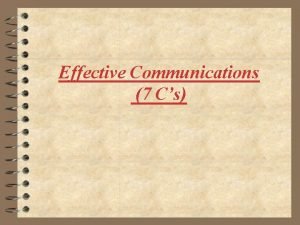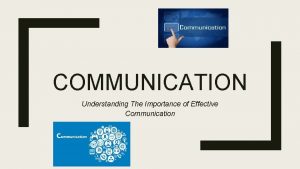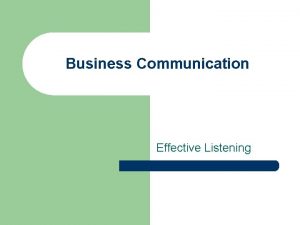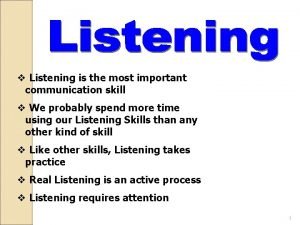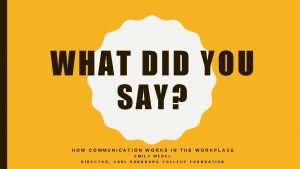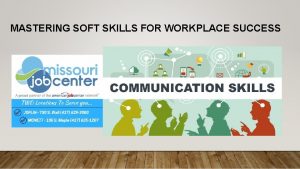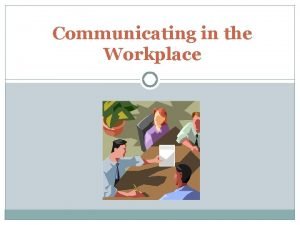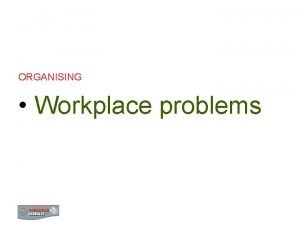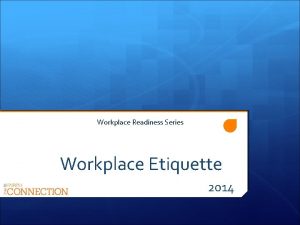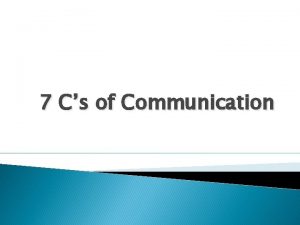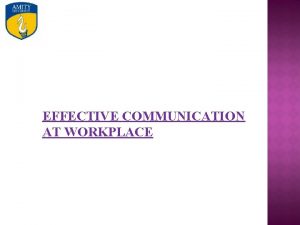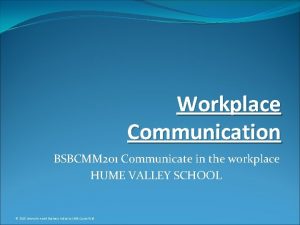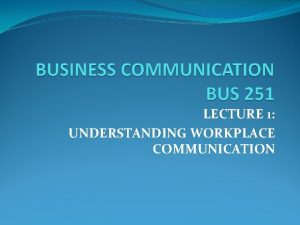Workplace Communication THE IMPORTANCE OF EFFECTIVE COMMUNICATION HOW










- Slides: 10

Workplace Communication THE IMPORTANCE OF EFFECTIVE COMMUNICATION HOW TO EFFECTIVELY COMMUNICATE AT WORK

What is WORKPLACE COMMUNICATION? Workplace communication means the transmitting of information between one person to another person or group. In the workplace, we communicate using many different methods such as orally, written documents, emails, visuals, and text messages. Communication can be verbal or non-verbal.

What is effective communication at work important to companies? • Key ingredient with succeeding as a company. • Good workplace communication allows a company to operate smoothly and to increase productivity. • When employees feel that good and open communication exist at work, they have a higher level of job satisfaction, less absenteeism, and lower turnover.

Why is it important for you to develop strong communication skills? • Good communication skills will help you get hired, land promotions, and be a success throughout your career. When asked to assess candidate skills/qualities, employers rated verbal communication skills the most important, according to NACE's Job Outlook 2016 report

What are FOUR important strategies that can help you improve your workplace communication skills? 1) 2) 3) 4) Learning to be an active listener. Clarifying messages when needed. Making sure your messages are clear and concise. Avoiding communication barriers.

Communication Strategies 1) LEARNING TO BE AN ACTIVE LISTENER. • When communicating with others you should practice active listening. Active listening is giving your full attention to the speaker, using all sense to listen, and showing the speaker you are listening. • When we are actively listening we pay attention to the body language, gestures, and the tone of voice of the speaker; this helps us understand what message they are trying to send to us. • Also, the listener needs to make sure to use the appropriate body language such as eye contact, smiling, or nodding to show they are receiving the message from the speaker. It is estimated that about 60 percent of the way we communicate is non-verbal.

Communication Strategies 2) CLARIFICATION In communication, clarification involves checking with the speaker on what he or she meant and resolving any confusion. • Clarification by the listener can be accomplished: 1) by summarizing/ rephrasing what the speaker said 2) and/or by asking questions. SUMMARIZING/ REPHRASING ASK CLARIFICATION-SEEKING QUESTIONS If you are not sure what someone at work is trying to say to you, then you can summarize or rephrase to them what you think they are trying to tell you. This gives the speaker the opportunity to add more information and clarify his or her message. Clarifying-seeking questions helps to remove uncertainty and to gain additional details. You want to make sure to obtain any necessary details before departing by asking questions using words such as when, where, how many, what time. . etc. . .

Communication Strategies 3) KEEP THE MESSAGE CLEAR AND CONCISE: • You need to make sure your message is clear, direct, and concise. Good communication means saying just enough to get your point across. No matter if it is in person, on the phone, text, or via email. • If you ramble, your listener will either tune you out or will be unsure of exactly what you need. • It is important to first think about what you want to say before you say it.

Communication Strategies 4) AVOID COMMUNICATION BARRIERS Communication barriers are specific items that can distort, destroy, or prevent communication in the workplace. • Communication barriers can be physical, cultural, linguistic or interpersonal in nature. • One of the most common types of communication barriers at work is related to people’s emotions. Emotions such as anger, fear, or resentment can easily distort or destroy a message. • If you are angry or upset, it is best to hold off responding to someone until you have settled down and cleared your head. Too often, workers will react without thinking and send angry messages or engage in conversation without thinking about the consequences. If an interaction or issue has upset you, take a half hour or more to let off some steam off before blurting out something you'll regret.

Final Thought Effective communication in the workplace is an essential skill and demanded by most all businesses and organizations. The four communication strategies; learning to be an active listener, clarifying messages when needed, making sure your messages are clear and concise, and avoiding communication barriers can be help you improve your communication skills. However, there are many other communication strategies that should be developed. Hence, you should never stop learning how to become a more effective communicator at work. The better you are with your communication abilities the more desirable you are as an employee and the more opportunities you will have for leadership and management positions.
 Consideration in communication
Consideration in communication Important of effective communication
Important of effective communication Objective of listening
Objective of listening Listening vs hearing
Listening vs hearing Why is communication important in the workplace
Why is communication important in the workplace Communication styles in the workplace
Communication styles in the workplace Mastering soft skills for workplace success
Mastering soft skills for workplace success Learning english through social issues writing
Learning english through social issues writing Hát kết hợp bộ gõ cơ thể
Hát kết hợp bộ gõ cơ thể Bổ thể
Bổ thể
